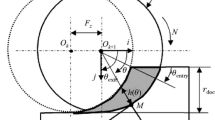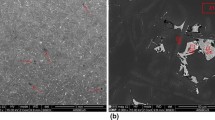Abstract
The evolution of chip morphology, chip formation, and surface topography (Ra, Rz) with cutting parameters has become an increasingly important way to achieve higher manufacturing efficiency and better surface topography. In this investigation, the relationships of chip morphology, chip formation, and surface topography with respect to cutting parameters are developed in dry milling of cast aluminum alloys with a PCD inserter. The feed rate affects the surface roughness, although no unanimous trend is observed between cutting parameters and surface topography. Surface crack propagation directly affects the saw-tooth chip morphology and the surface topography. The chip morphology is transformed from saw-tooth to continuous type at a chip deformation ratio of 3; chip deformation ratios of 2.5, 1.875, and 1.25 achieve cutting velocities of 32.71, 35.98, and 39.25 m/s, respectively, in which a continuous chip is formed by surface crack propagation and the predominant effect of thermal softening and surface topography is significantly improved.
Similar content being viewed by others
References
G. S. Goindi and P. Sarkar, Dry machining: a step towards sustainable machining-challenges and future directions, Journal of Cleaner Production, 165 (2017) 1557–1571.
V. P. Astakhov, Tribology of Metal Cutting, 1st Ed., Elsevier Science Ltd., Amsterdam, Netherland (2006).
P. G. Benardos and G. C. Vosniakos, Predicting surface roughness in machining: a review, International Journal of Machine Tools and Manufacture, 43 (2003) 833–844.
M. C. Shaw and A. Vyas, The mechanism of chip formation with hard turning steel, CIRP Annals-Manufacturing Technology, 47 (1998) 77–82.
A. Vyas and M. C. Shaw, Mechanics of saw-tooth chip formation in metal cutting, Journal of Manufacturing Science and Engineering, Transactions of the ASME, 121 (1999) 163–172.
M. A. Davies, T. J. Burns and C. J. Evans, On the dynamic of chip formation in machining hard metals, CIRP Annals-Manufacturing Technology, 46 (1997) 25–30.
K. Nakayama, The formation of saw tooth chips, Proc. of the International Conference on Production Engineering, Tokyo, Japan (1974) 26–29.
H. A. Kishawy, M. Dumitrescu and E.-G. Ng, Effect of coolant strategy on tool performance, chip morphology and surface quality during high-speed machining of A356 aluminum alloy, International Journal of Machine Tools and Manufacture, 45 (2005) 219–227.
A. E. Bayoumi and J. Q. Xie, Some metallurgical aspects of chip formation in cutting Ti-6wt%Al-4wt%V alloy, Materials Science and Engineering A, 124 (2002) 528–535.
M. A. Elbestawi, A. K. Srivastava and T. I. El-Wardany, A model for chip formation during machining of hardened steel, CIRP Annals-Manufacturing Technology, 45(1) (1996) 71–76.
R. Komanduri, T. Schroeder and B. F. V. Turkovich, On the catastrophic shear instability in high speed machining of an AISI4340, Journal of Manufacturing Science and Engineering, Transactions of the ASME, 104 (1982) 121–131.
W. Jomaa, O. Mechri, J. Lévesque, V. Songmene, P. Bocher and A. Gakwaya, Finite element simulation and analysis of serrated chip formation during high-speed machining of AA7075-T651 alloy, Journal of Manufacturing Processes, 26 (2017) 446–458.
L. Y. Gu, G. Z. Kang, H. Chen and M. Wang, On adiabatic shear fracture in high-speed machining of martensitic precipitation-hardening stainless steel, Journal of Materials Processing Technology, 234 (2016) 208–216.
J. Barry and G. Byrne, The mechanisms of chip formation in machining hardened steels, Journal of Manufacturing Science and Engineering, Transactions of the ASME, 124 (2002) 528–535.
Y. B. Guo and D. W. Yen, A FEM study on mechanisms of discontinuous chip formation in hard machining, Journal of Materials Processing Technology, 155–156 (2004) 1350–1356.
R. Kountanya, I. Al-Zkeri and T. Altan, Effect of tool edge geometry and cutting conditions on experimental and simulated chip morphology in orthogonal hard turning of 100Cr6 steel, Journal of Materials Processing Technology, 209 (2009) 5068–5076.
R. Komanduri, Some clarifications of the mechanics of chip formation when machining titanium alloys, Wear, 76 (1982) 15–34.
B. Davis, D. Dabrow and R. Newell, Chip morphology and chip formation mechanisms during machining of ECAE-processed titanium, Journal of Manufacturing Science and Engineering, Transactions of the ASME, 40 (2018) 031008.
T. Mabrouki and J. F. Rigal, A contribution to a qualitative understanding of thermo-mechanical effects during chip formation in hard turning, Journal of Materials Processing Technology, 176 (2006) 214–221.
R. W. Maruda, M. G. Krolczyk, P. Nieslony, S. Wojciechowski, M. Michalski and S. Legutko, The influence of the cooling conditions on the cutting tool wear and the chip formation mechanism, Journal of Manufacturing Processes, 24 (2016) 107–115.
G. Sutter and G. List, Very high speed cutting of Ti-6Al-4V titanium alloy-change in morphology and mechanism of chip formation, International Journal of Machine Tools and Manufacture, 66 (2013) 37–43.
S. Zhang and Y. B. Guo, An experimental and analytical analysis on chip morphology, phase transformation, oxidation, and their relationships in finish hard milling, International Journal of Machine Tools and Manufacture, 49 (2009) 805–813.
C. Y. Wang, Y. X. Xie and L. J. Zheng, Research of the chip formation mechanism during the high-speed milling of hardened steel, International Journal of Machine Tools and Manufacture, 79 (2014) 31–48.
A. Honeycutt and L. S. Tony, Surface location error and surface roughness for period-n milling bifurcations, Journal of Manufacturing Science and Engineering, Transactions of the ASME, 139 (2017) 061010.
S. Zhang and Y. B. Guo, Taguchi method based process space for optimal surface topography by finish hard milling, Journal of Manufacturing Science and Engineering, Transactions of the ASME, 131 (2009) 051003.
B. Denkena, M. Kruger and D. Bachrathy, Model based reconstruction of milled surface topography from measured cutting forces, International Journal of Machine Tools and Manufacture, 54–55 (2012) 25–33.
I. Buj-Corral, J. Vivancos-Calvet and A. Domín guez-Fernández, Surface topography in ball-end milling processes as a function of feed per tooth and radial depth of cut, International Journal of Machine Tools and Manufacture, 53 (2012) 151–159.
N. S. K. Reddy and P. V. Rao, Selection of an optimal parametric combination for achieving a better surface finish in dry milling using genetic algorithms, International Journal of Advanced Manufacturing Technology, 28 (2006) 463–473.
B. K. Singh, H. Roy, B. Mondal, S. Roy and N. Mandal, Measurement of chip morphology and multi criteria optimization of AISI 4340 steel using Y-ZTA cutting insert, Measurement, 142 (2019) 181–194.
A. Saini, S. Dhiman, R. Sharma and S. Setia, Experimental estimation and optimization for process parameters under minimum quantity lubrication and dry turning of AISI-4340 with different carbide inserts, Journal of Mechanical Science and Technology, 28(6) (2014) 2307–2318.
Y. Li, G. Zheng, X. Zhang, X. Cheng, X. Yang and R. Xu, Cutting force, tool wear and surface roughness in high-speed milling of high-strength steel with coated tools, Journal of Mechanical Science and Technology, 33(11) (2019) 5393–5398.
V. Sivaraman and S. Prakash, Performance and evaluation of MoS2 based machining using PVD-TiAlN coated tool, Journal of Mechanical Science and Technology, 33(9) (2019) 4383–4388.
Y. Zhou, H. Sun, A. Li, M. Lv, C. Xue and J. Zhao, FEM simulation-based cutting parameters optimization in machining aluminum-silicon piston alloy ZL109 with PCD tool, Journal of Mechanical Science and Technology, 33(7) (2019) 3457–3465.
S. R. Das, D. Dhupal and A. Kumar, Experimental investigation into machinability of hardened AISI 4140 steel using TiN coated ceramic tool, Measurement, 62 (2015) 108–126.
A. Das, S. K. Patel, T. K. Hotta and B. Biswal, Statistical analysis of different machining characteristics of EN-24 alloy steel during dry hard turning with multilayer coated cermet inserts, Measurement, 134 (2019) 123–141.
H. Schultz, High speed milling of aluminum alloys, High Speed Machining, ASME, New York (1984).
R. Kamguem, A. Djebara and V. Songmene, Investigation on surface finish and metallic particle emission during machining of aluminum alloys using response surface methodology and desirability functions, International Journal of Advanced Manufacturing Technology, 69 (2013) 1283–1298.
R. Khettabi, M. Nouioua and A. Djebara, Effect of MQL and dry processes on the particle emission and part quality during milling of aluminum alloys, International Journal of Advanced Manufacturing Technology, 92 (2017) 2593–2598.
Acknowledgments
This work was supported by the Natural Science Foundation of Hunan Province (Grant No. 2020JJ411 5), and the National Natural Science Foundation of China (Grant Nos. 51535012, U1604255).
Author information
Authors and Affiliations
Corresponding authors
Additional information
Recommended by Editor Hyung Wook Park
Xuelin Chen received his M.S. from the School of Mechanical and Automotive Engineering at South China University of Technology, China in 2014. He is a Ph.D. Candidate at Central South University. His research interests include machining dynamics, high-speed machining, ultrasonic vibration-assisted machining, and gear design.
Jinyuan Tang is a Professor at the School of Mechanical and Electrical Engineering and State Key Laboratory of High Performance Complex Manufacturing of Central South University, Changsha, PR China. His research interests include dynamics, gear design, machine design, and manufacturing.
Han Ding is an Associate Professor at the School of Mechanical and Electrical Engineering and State Key Laboratory of High Performance Complex Manufacturing of Central South University, Changsha, PR China. His research interests include gear design, machine design, and manufacturing.
Anmin Liu is a Professor at the Institute of Automobile Parts Technology and State Key Engineering Laboratory of Automobile Parts Design and Manufacturing of Hunan Institute of Technology, Hengyang, PR China. His research interests include high-speed machining and dynamics.
Rights and permissions
About this article
Cite this article
Chen, X., Tang, J., Ding, H. et al. Experimental study on the evolution of chip morphology, chip formation, and surface topography with cutting parameters, and their relationships in dry milling of cast aluminum alloy with PCD inserter. J Mech Sci Technol 35, 1651–1662 (2021). https://doi.org/10.1007/s12206-021-0328-3
Received:
Revised:
Accepted:
Published:
Issue Date:
DOI: https://doi.org/10.1007/s12206-021-0328-3




